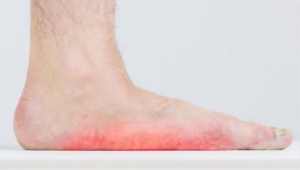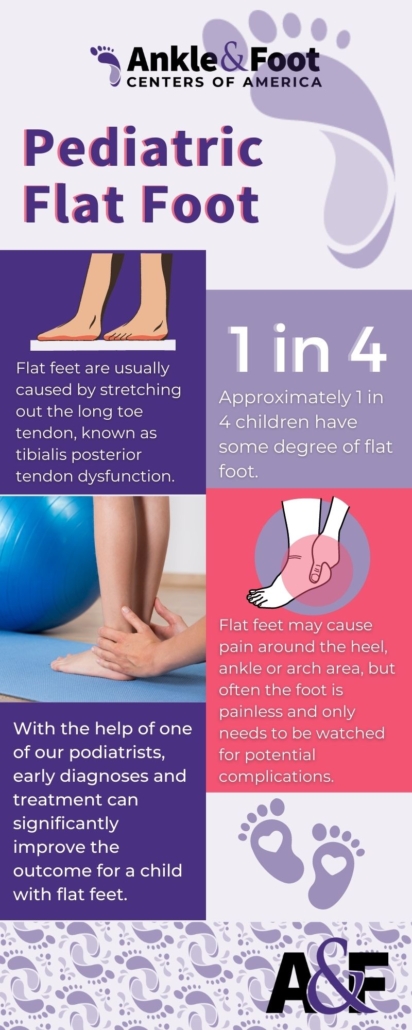 Flat feet are a perfectly normal condition for both children and adults. However, in some cases, the flatness of your child’s feet could become a more serious issue with pediatric flatfoot. Pediatric flatfoot is an abnormal deformity in which the foot collapses inward during walking, causing pain and impairing mobility. Although this condition is not incredibly common, it’s still important to know the symptoms and signs so you can take preventative measures. The most common signs are pain or soreness on the inner side of their foot or ankle, limited flexibility while moving around, instabilities while raising each heel off the ground or standing on tiptoes and discomfort or tiredness while walking even short distances. If you notice any of these things in your child, be sure to schedule an appointment with your podiatrist as soon as possible for a proper diagnosis and treatment plan.
Flat feet are a perfectly normal condition for both children and adults. However, in some cases, the flatness of your child’s feet could become a more serious issue with pediatric flatfoot. Pediatric flatfoot is an abnormal deformity in which the foot collapses inward during walking, causing pain and impairing mobility. Although this condition is not incredibly common, it’s still important to know the symptoms and signs so you can take preventative measures. The most common signs are pain or soreness on the inner side of their foot or ankle, limited flexibility while moving around, instabilities while raising each heel off the ground or standing on tiptoes and discomfort or tiredness while walking even short distances. If you notice any of these things in your child, be sure to schedule an appointment with your podiatrist as soon as possible for a proper diagnosis and treatment plan.
Table of Contents
Prevalence of Flat Feet in Children
Flat feet can be found in a substantial portion of the population, and even more so among children. Fortunately, most cases are asymptomatic and will disappear without any treatment or further medical monitoring – as a child’s foot develops, it can gradually begin to form its own shape and the appearance of flat feet will lessen. However, pediatric flat foot is a more persistent condition that is seen in an estimated 3-4% of children – if this type of flat feet is suspected your child needs prompt evaluation from a podiatrist to assess their individual needs and confirm whether treatments or therapies are required.
Causes of Flat Feet/Pediatric Flat Foot
There are numerous factors that can contribute to the development of flat feet or pediatric flatfoot. In some cases, the problem is simply due to genetics and nothing can be done to prevent it. Other causes include injuries or trauma to the foot, prolonged standing or sitting, obesity, and certain medical conditions such as arthritis or diabetes.

Symptoms
The vast majority of children with flat feet won’t experience any problems or pain. In fact, many won’t even know they have the condition unless it is assessed by a medical professional. However, some children may develop symptoms such as pain in the foot or ankle, swelling, difficulty walking, or limping. If your child is experiencing any of these symptoms, it is important to see a podiatrist for an assessment.
Diagnosis
A diagnosis for flat feet and pediatric flatfoot can usually be easily made with a thorough physical examination. Your podiatrist may examine your child’s feet from every angle and will ask about the family history of similar symptoms, as well as any other medical conditions. For further inquiry, he/she may suggest certain tests as a means to gain more insight such as X-rays, ultrasounds, MRIs, or a gait analysis. In any case, it is important for your child’s foot health that flatfoot is properly diagnosed in order to develop effective methods of treatment.

Treatment Options
Most children with flat feet won’t require any treatment, as their feet will continue to develop and change shape as they grow older. In many cases, the condition will improve on its own without intervention. If your child is experiencing pain or discomfort, however, there are a number of different treatment options available that can help alleviate their symptoms. These include orthotics (custom arch supports), bracing, physical therapy exercises, and lifestyle modifications such as losing weight if they are obese. In more severe cases where conservative treatments haven’t worked, surgical options may be considered such as soft tissue release, tendon transfer, and bone realignment procedures.
When your child’s feet are of concern, it is important to take action quickly. Seeing a podiatrist for an assessment can provide you with the tools and knowledge to create a treatment plan that benefits both you and your child.
Podiatrists are highly experienced in diagnosing foot conditions, making them the perfect source for learning about proper care and development of your child’s feet. The earlier these issues are addressed, the better able your child will be to lead an active lifestyle with healthy feet. Therefore, don’t hesitate getting your child assessed by a podiatrist if their foot development has you worried.






